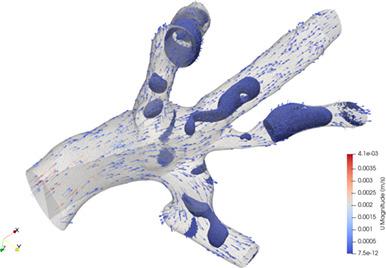当前位置:
X-MOL 学术
›
Int. J. Numer. Method. Biomed. Eng.
›
论文详情
Our official English website, www.x-mol.net, welcomes your
feedback! (Note: you will need to create a separate account there.)
Lattice Boltzmann simulation of transient blood flow in arterial geometries using a regularised, viscoplastic and shear-thinning fluid
International Journal for Numerical Methods in Biomedical Engineering ( IF 2.2 ) Pub Date : 2021-03-20 , DOI: 10.1002/cnm.3456 Bryce M Hill 1 , Christopher R Leonardi 1
International Journal for Numerical Methods in Biomedical Engineering ( IF 2.2 ) Pub Date : 2021-03-20 , DOI: 10.1002/cnm.3456 Bryce M Hill 1 , Christopher R Leonardi 1
Affiliation

|
This paper presents a lattice Boltzmann framework for the transient simulation of blood flow using biologically inspired geometries and pressure boundary conditions. The Kuang-Luo rheological model is used to represent blood as a homogeneous continuum. This model includes the two primary non-Newtonian characteristics of blood, namely viscoplasticity and pseudoplasticity. This paper makes two contributions. First, the numerical challenges associated with zero strain rates and infinite viscosity, as a consequence of the yield stress in the Kuang-Luo model, were addressed by regularising the constitutive equation so that the viscosity tends towards a finite value at low strain rates. A two-relaxation-time operator, which exhibits improved performance over the single-relaxation-time operator and lower computational overhead than the multiple-relaxation-time operator, is employed in the collision process. The recursive relationship between the local strain rate and relaxation rate was addressed by use of an implicit solver for these two quantities. The implemented model was benchmarked against analytic solutions for Poiseuille flow between parallel plates in two dimensions and in a cylindrical tube in three dimensions. More importantly, the transient performance of the implemented model was demonstrated by matching the predicted start-up flow of the Poiseuille flow of a Bingham fluid with the corresponding analytical solution. Second, the numerical developments were applied in the simulation of transient blood flow in complex configurations. The development and implementation of physically inspired pressure profiles highlighted the shortcomings of using a sinusoidal pressure profile in the prediction of velocity and stress distributions. Finally, the simulation of blood flow in a section of a carotid artery indicated a number of flow characteristics that will be of interest to future investigations of clinical problems.
中文翻译:

使用规则化、粘塑性和剪切稀化流体对动脉几何结构中的瞬态血流进行格子 Boltzmann 模拟
本文提出了一个格子 Boltzmann 框架,用于使用受生物启发的几何形状和压力边界条件对血流进行瞬态模拟。Kuang-Luo 流变模型用于将血液表示为均匀连续体。该模型包括血液的两个主要非牛顿特性,即粘塑性和假塑性。本文有两个贡献。首先,作为匡洛模型中屈服应力的结果,与零应变率和无限粘度相关的数值挑战通过正则化本构方程来解决,以便在低应变率下粘度趋于有限值。一个二松弛时间算子,在碰撞过程中采用了比单松弛时间算子更好的性能和比多松弛时间算子更低的计算开销。通过对这两个量使用隐式求解器来解决局部应变率和松弛率之间的递归关系。实施的模型以二维平行板之间和三维圆柱管中泊肃叶流的解析解为基准。更重要的是,通过将宾汉流体的泊肃叶流的预测启动流与相应的解析解相匹配,证明了所实现模型的瞬态性能。其次,数值发展应用于模拟复杂配置的瞬态血流。物理启发压力分布的开发和实施突出了使用正弦压力分布预测速度和应力分布的缺点。最后,对颈动脉部分血流的模拟表明了许多血流特征,这些特征将对未来临床问题的研究感兴趣。
更新日期:2021-03-20
中文翻译:

使用规则化、粘塑性和剪切稀化流体对动脉几何结构中的瞬态血流进行格子 Boltzmann 模拟
本文提出了一个格子 Boltzmann 框架,用于使用受生物启发的几何形状和压力边界条件对血流进行瞬态模拟。Kuang-Luo 流变模型用于将血液表示为均匀连续体。该模型包括血液的两个主要非牛顿特性,即粘塑性和假塑性。本文有两个贡献。首先,作为匡洛模型中屈服应力的结果,与零应变率和无限粘度相关的数值挑战通过正则化本构方程来解决,以便在低应变率下粘度趋于有限值。一个二松弛时间算子,在碰撞过程中采用了比单松弛时间算子更好的性能和比多松弛时间算子更低的计算开销。通过对这两个量使用隐式求解器来解决局部应变率和松弛率之间的递归关系。实施的模型以二维平行板之间和三维圆柱管中泊肃叶流的解析解为基准。更重要的是,通过将宾汉流体的泊肃叶流的预测启动流与相应的解析解相匹配,证明了所实现模型的瞬态性能。其次,数值发展应用于模拟复杂配置的瞬态血流。物理启发压力分布的开发和实施突出了使用正弦压力分布预测速度和应力分布的缺点。最后,对颈动脉部分血流的模拟表明了许多血流特征,这些特征将对未来临床问题的研究感兴趣。











































 京公网安备 11010802027423号
京公网安备 11010802027423号